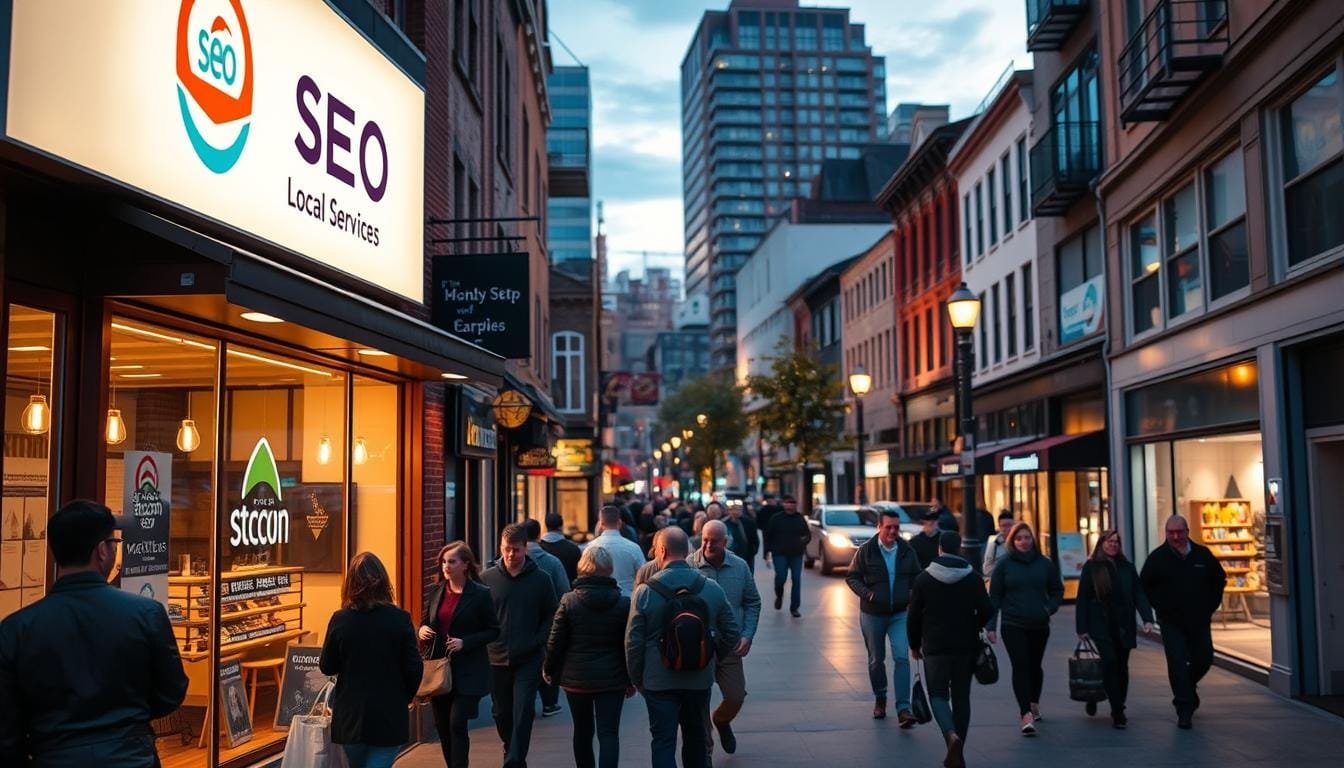What if your neighbourhood shop could outrank global chains in local search results? As customers increasingly search for nearby solutions, this question becomes urgent for Indian enterprises. One in five shoppers now discover stores through online queries – a trend accelerating faster than ever.
Traditional marketing no longer suffices. Geographical relevance and community connections now drive visibility. Platforms like Bizansy simplify this shift, helping enterprises adapt without technical headaches.
The stakes? Missed opportunities for foot traffic and revenue. But get it right, and even modest ventures can dominate their postcodes. This guide reveals how to:
– Align with 2025’s search algorithm updates
– Convert casual browsers into loyal customers
– Measure real-world impacts of digital efforts
Success demands more than basic listings. It requires understanding how mobile searches, voice queries, and hyperlocal content reshape consumer behaviour. Prioritise these elements, and watch your business rise above competitors – both online and on the street.
Why Local SEO for Small Businesses Matters in 2025

India’s digital landscape now rewards enterprises that speak their community’s language – literally. Over 68% of urban consumers check their phones within an hour of needing a service, according to recent industry reports. This urgency reshapes how establishments compete in hyperlocal markets.
The Trio That Dictates Search Positions
Google’s ranking formula balances three elements like a skilled chef. Relevance demands your profile answers exact questions – “24-hour chemist near me” requires specific operational details. Distance calculations now factor in colloquial landmarks, recognising searches like “near Chhatrapati Square” alongside GPS coordinates.
Prominence isn’t just about five-star reviews anymore. As Mumbai-based retailer Priya Kapoor notes:
“Our WhatsApp orders tripled after adding neighbourhood festival timings to our profile.”
This cultural alignment boosts both online visibility and foot traffic.
India’s Mobile-First Search Evolution
Voice searches for phrases like “best ₹500 saree shop” grew 140% last year. Platforms like Bizansy help enterprises adapt through regional keyword tools and localised backlink strategies. Meanwhile, AI now detects authenticity – templated descriptions lose to specifics like “Kerala-style banana leaf packaging”.
The future belongs to businesses weaving local dialects and traditions into their digital presence. Those mastering this blend will dominate both screens and streets.
Setting Up and Organising Your Google Business Profile

Your digital storefront begins with precise groundwork. A well-structured Google Business Profile acts as both a search magnet and customer handbook. Over 84% of Indian consumers abandon incomplete listings, per recent market studies.
Crafting Credibility Through Verification
Initiate your presence by selecting “Manage now” on Google’s platform. Verification options – postcard, email, or instant methods – adapt to your operational needs. Bengaluru café owner Arjun Mehta shares:
“Video verification took 8 minutes. Now we appear in ‘open now’ searches during monsoons.”
Post-verification, prioritise these elements:
- Name & address: Match legal registrations exactly – “Sri Lakshmi Sweets” not “Laxmi Sweets”
- Categories: Primary (e.g., “Saree Retailer”) followed by secondary (“Bridal Accessories”)
- Hours: Update for festivals like Diwali closures
Integrate tools like Bizansy to sync inventory and bookings automatically. Their dashboard shows real-time profile performance alongside POS data – crucial for Gujarati jewellers managing wedding season rushes.
Descriptions should blend keywords like “handloom cotton dresses” with cultural context. A Surat textile shop increased enquiries 40% by mentioning “Garba night special discounts”.
Weekly photo uploads of new arrivals or staff training sessions boost engagement. Google’s algorithms favour profiles updated more than monthly, pushing them 23% higher in “near me” searches.
Implementing Local SEO for small businesses Strategies

India’s shopkeepers face a curious paradox – their physical presence anchors communities, yet digital accuracy determines discovery. A single mismatched phone number across platforms can sink search rankings faster than monsoon floods.
Precision in Profile Crafting
Your business profile acts as a digital nametag. Platforms like Bizansy simplify synchronising NAP details across 85+ directories. Chennai caterer Ramesh Iyer confirms:
“Fixing ‘East Mada Street’ versus ‘E Mada St’ discrepancies boosted our wedding enquiries by 30%.”
Descriptions demand strategic flair. A Jaipur jeweller increased conversions 22% by weaving “Kundan polki sets” and “Mehndi function discounts” into their bio.
Visual Storytelling That Converts
Authentic photos outperform stock images. Google prioritises profiles updated weekly with:
- Behind-the-scenes workshop footage
- New product demonstrations
- Festive décor shots (Diwali lights, Holi colours)
Kolkata sari boutique owner Ananya Das shares: “Clients book appointments after seeing exact blouse designs in our gallery.”
Regular Google Posts featuring regional offers – think “Monsoon tyre checks” or “Puja thali pre-orders” – keep profiles fresh. Combine this with mobile-friendly videos under 15 seconds, and watch engagement metrics climb.
Enhancing Local Visibility Through Reviews and Backlinks

Imagine your shop appearing first when locals search for services they need daily. Google’s algorithms now prioritise establishments that combine authentic feedback with neighbourhood credibility. Over 76% of Indian consumers check ratings before visiting stores, making review management a game-changer for visibility.
Managing Reviews and Customer Engagement Effectively
Positive ratings directly influence your position in search results. Platforms like Bizansy streamline feedback collection across Google, Justdial, and regional apps. Mumbai caterer Deepika Rao shares:
“Responding to reviews within 4 hours doubled our ‘top 3’ appearances for ‘wedding caterers near me’.”
Key tactics include:
- Encouraging feedback via QR codes on receipts
- Addressing negative comments with solutions, not excuses
- Highlighting regional terms like “same-day delivery” in responses
Building Quality Backlinks to Boost Credibility
Authoritative links from community portals work better than generic directories. Partner with:
- Local trade associations
- Neighbourhood event organisers
- Complementary shops (e.g., florists linking to wedding venues)
A Pune bakery gained 18% more footfall after being featured on a “Best Vada Pav” blog by a food influencer.
Embracing Mobile Optimisation and Local Keywords
With 92% of Indian searches happening on phones, ensure your site loads in 2.3 seconds. Integrate phrases like “24/7 chemist Colaba” or “Marathi-speaking electricians”. Google’s mobile-first indexing means slow pages vanish from local search ranking.
Tools like Bizansy analyse regional language patterns, helping tailor content that resonates. Remember – what works in Chennai (“saree”) differs from Kolkata (“sari”).
Localising Your Website and Content for Better SEO Performance

Your digital storefront must adapt to community needs as deftly as your physical shop. Over 63% of Indian consumers abandon sites lacking clear location cues, per recent analytics. Technical precision now separates thriving enterprises from invisible ones.
Structuring Meta Tags and Schema Markups
Title tags should mirror how locals search – “Marathi-speaking electricians in Pune” outperforms generic phrases. Tools like IONOS Website Builder simplify meta optimisation, automatically embedding area-specific keywords.
Schema markups act as digital signposts. Implement these elements:
- LocalBusiness schema with exact opening hours
- GeoCoordinates matching Google My Business listings
- ServiceArea markup for mobile operations
Ahmedabad-based caterer Riya Patel notes:
“Adding ‘Satellite Road’ to our schema brought 18% more lunch orders.”
Anchoring Your Physical Presence
Homepage elements build trust. Display your address above the fold using text – not images. Mention nearby landmarks like “opposite Howrah Station” for better context.
Create location pages for each service area. A Nagpur hardware store increased conversions by:
- Detailing monsoon-proofing services for specific colonies
- Embedding WhatsApp buttons with area-specific quick replies
- Showcasing staff speaking regional dialects in videos
Update blogs weekly with hyperlocal content – think “Ganesh Chaturthi storage solutions” or “Bengaluru rainwater harvesting tips”. This freshness signals active community participation to search engines.
Conclusion
Mastering neighbourhood visibility demands more than occasional updates—it requires a strategic ecosystem. Consistency across profiles, listings, and customer interactions forms the backbone of modern search success. Businesses must monitor citations and synchronise operational details like working hours across all platforms.
Effective management tools prove invaluable here. Solutions such as e-commerce integrations streamline updates while tracking performance metrics. Combine this with authentic review responses and region-specific content about products services, and enterprises build lasting digital credibility.
Future-proof strategies prioritise mobile-first content and hyperlocal keywords. Regular photo updates showcasing seasonal offers or community events boost engagement. Remember—search engines increasingly reward businesses that mirror real-world authenticity in their online presence.
The path to better ranking lies in continuous adaptation. By blending technical precision with cultural relevance, enterprises secure their place in both local searches and neighbourhood life.











